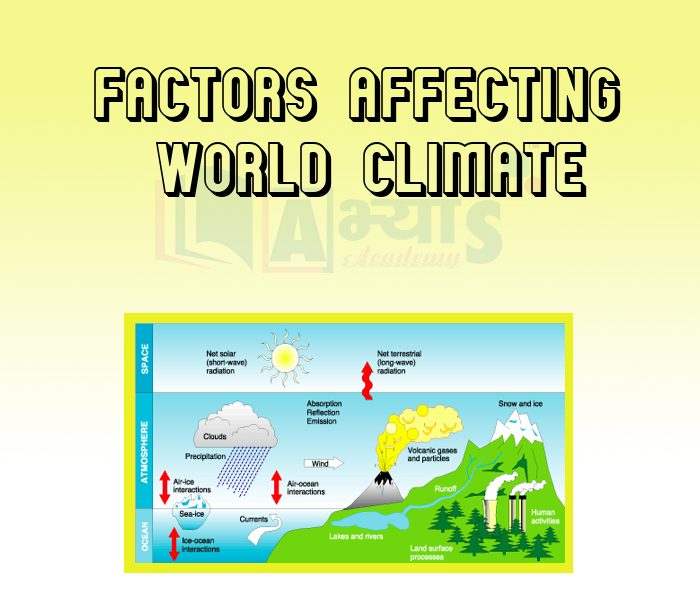Factors Affecting World Climate












Factors Affecting World Climate
Factors Affecting Climate: There are many different factors, which affect climate around the world.
The most important factors are:
Distance from the Sea (Continentally) : The sea affects the climate of a place. Coastal areas are cooler and wetter than inland areas. Clouds form when warm air from inland areas meets cool air from the sea. The centre of continents is subject to a large range of temperatures. In summers, temperatures can be very hot and dry, as moisture from the sea evaporates before it reaches the centre of the continent
Direction of Prevailing Winds: Winds that blow from the sea often bring rain to the coast and drY weather to inland areas Winds that blow to Britain from warm inland areas such as Africa will be warm and dry. Winds that blow to Britain from inland areas such as the Netherlands will be cold and dry in winter. Britain's prevailing winds come from a Southwesterly direction over the Atlantic. The winds are cool in the summers arnd mild in the winters.
Altitude: Climate can be affected by mountains. Mountains receive more rainfall than low-lying areas because the temperature on top of mountains is lower than the temperature at sea level. That is why you often see snow on the top of mountains all year round. The higher the place is above sea level, the colder it will This happens because as altitude increases, air becomes thinner and is less able to absorb and retain heat.Proximity to the Equator: The proximity to the equator affects the climate of a place. The equator receives more sunlight than any other place does on earth. This is due to its position in relation to the sun. The equator is hotter because the sun has less area to heat. It is cooler at the north and south poles as the sun has more area to heat up.
El Nino: El Nino, which affects wind and rainfall patterns, has been blamed for droughts and loods in countries around the Paciffic. Rim. El Nino refers to the irregular warming of surface water in the Pacific, The warmer water pumps energy and moiÅŸture into the atmosphere, altering global wind and rainfall patterms The phenomenon has caused tornadoes in Florida, smog in Indonesia, and forest fires in Brazil (see below).
Human Influence: The factors above affect the climate naturally. However, we cannot forget the influence of humans on our climate. We have been affecting the climate since we appeared on this earth millions of years ago. In those times, the affect on the climate was small. Trees were cut down to provide wood for fires. Trees take in carbon dioxide and produce oxygen. A reduction in trees, therefore, increases the amount of carbon dioxide in the atmosphere.The Industrial Revolution, starting at the end of the 19th Century, has had a huge effect on climate. The invention of the motor engine and the increased burning of fossil fuels have increased the amount of carbon dioxide in the atmosphere. The number of trees being cut down has also increased, meaning that the extra carbon dioxide produced cannot be changed into oxygen.
Students / Parents Reviews [10]
My experience with Abhyas is very good. I have learnt many things here like vedic maths and reasoning also. Teachers here first take our doubts and then there are assignments to verify our weak points.

Shivam Rana
7thMy experience was very good with Abhyas academy. I am studying here from 6th class and I am satisfied by its results in my life. I improved a lot here ahead of school syllabus.

Ayan Ghosh
8thBeing a parent, I saw my daughter improvement in her studies by seeing a good result in all day to day compititive exam TMO, NSO, IEO etc and as well as studies. I have got a fruitful result from my daughter.

Prisha Gupta
8thMy experience with Abhyas academy is very good. I did not think that my every subject coming here will be so strong. The main thing is that the online tests had made me learn here more things.

Hiya Gupta
8thI have spent a wonderful time in Abhyas academy. It has made my reasoning more apt, English more stronger and Maths an interesting subject for me. It has given me a habbit of self studying

Yatharthi Sharma
10thOne of the best institutes to develope a child interest in studies.Provides SST and English knowledge also unlike other institutes. Teachers are co operative and friendly online tests andPPT develope practical knowledge also.

Aman Kumar Shrivastava
10thAbhyas Methodology is very good. It is based on according to student and each child manages accordingly to its properly. Methodology has improved the abilities of students to shine them in future.

Manish Kumar
10thAbout Abhyas metholodology the teachers are very nice and hardworking toward students.The Centre Head Mrs Anu Sethi is also a brilliant teacher.Abhyas has taught me how to overcome problems and has always taken my doubts and suppoeted me.

Shreya Shrivastava
8thIt was a good experience with Abhyas Academy. I even faced problems in starting but slowly and steadily overcomed. Especially reasoning classes helped me a lot.

Cheshta
10thA marvelous experience with Abhyas. I am glad to share that my ward has achieved more than enough at the Ambala ABHYAS centre. Years have passed on and more and more he has gained. May the centre flourish and develop day by day by the grace of God.
